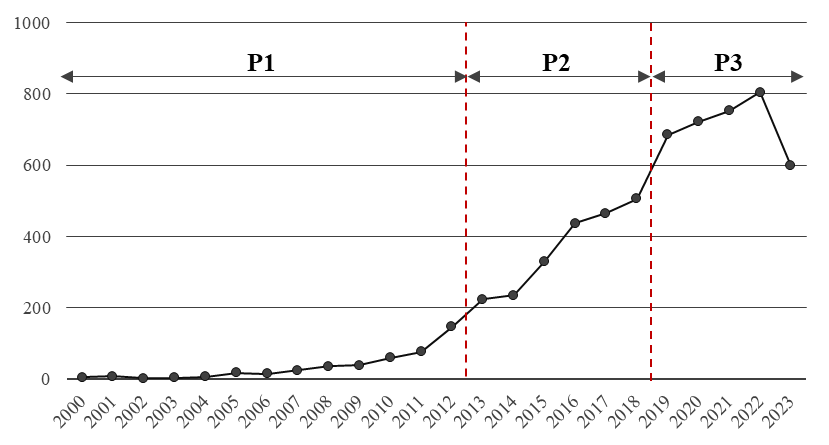1.
Introduction
‘Digital humanities’ is a discipline formed through the fusion of humanities research and technology, making it a highly interdisciplinary field. A considerable portion of researches crosses over academic boundaries and offers a variety of research that views traditional paradigms from new perspectives. Through this fusion and integration, we gain deeper insights into humanistic understanding and the human condition. In this study, we explored the interdisciplinarity and diversity of research areas in digital humanities, focusing on key research papers that have influenced the field’s development by utilizing bibliographic data. Bibliographic data consisted of a core dataset that encapsulated the vast achievements accumulated by researchers over time, effectively revealing the macro trends and patterns of integration in the discipline. Using bibliographic data, this study intended to examine the main research areas, principal trends, and the evolution of prominent research themes over time in digital humanities.
2.
Data Collection and Method
For this study, we collected a total of 6,224 bibliographic data related to digital humanities from the Scopus database. The collected bibliographic data included 246,202 references and 10,720 authors.
The publication trend of research related to digital humanities by year is shown in Figure 1. Papers using ‘digital humanities’ as a keyword have been present since before 2000, however, research explicitly using the term ‘digital humanities’ significantly increased started from the 2010s, with notable increases in 2013 and 2019. This study, therefore, examined the changes in the key research areas of each period based on three periods: 2000 to 2012 (P1), 2013 to 2018 (P2), and 2019 to 2022 (P3).
Figure 1. The number of articles by year
This study examines the bibliographic data that have significantly influenced digital humanities, as well as main research areas, and the differences in research areas over time. To this end, we will utilize citation frequency, document co-citation analysis, and network analysis. The document co-citation analysis (DCA) is known as effective method for conducting comprehensive literature reviews and locating significant research quickly(Small, 1973). Furthermore, interdisciplinary connections to be detected by DCA will facilitate the understanding of cross-disciplinary influences and will grasp the dynamics of scientific research and knowledge development.
3.
Key Literature and Research Areas in DH
Initially, to measure research impact, the most frequently cited references were calculated. Table 2 shows the 10 most highly cited papers, representing the core literature in Digital Humanities research. As shown in Table 2, the 10 papers covered a diverse range of topics demonstrating the field's interdisciplinary nature dating from the early 2000s to the early 2010s. The most cited was the publication by Franco Moretti from 2005. Moretti’s influence further highlighted as his 2013 work ranked second. It was shown that the topical diversity of the top 10 most frequently cited papers such as research discussing the overall discourse in digital humanities, macroscopic approaches, and the influences of media and computing had emerged as the core literature in the field.
Table 2. Top 10 references in the digital humanities field
| Rank |
Title |
Year |
Authors |
# Citations |
| 1 |
Graphs maps trees abstract models for a literary history |
2005 |
Moretti, F. |
172 |
| 2 |
Distant reading |
2013 |
Moretti, F. |
165 |
| 3 |
A companion to digital humanities |
2004 |
Schreibman, S, Siemens, R, & Unsworth, J. |
143 |
| 4 |
Macro analysis digital methods and literary history 2013 |
2013 |
Jockers, M.L. |
131 |
| 5 |
Digital humanities |
2012 |
Burdick, A. el al. |
111 |
| 6 |
Debates in the digital humanities |
2012 |
Gold, M.K. |
105 |
| 7 |
The language of new media |
2001 |
Manovich, L. |
80 |
| 8 |
The landscape of digital humanities digital humanities quarterly |
2010 |
Svensson, P. |
77 |
| 9 |
Humanities approaches to graphical display digital humanities quarterly |
2011 |
Drucker, J. |
74 |
| 10 |
The history of humanities computing a companion to digital humanities |
2004 |
Hockey, S. |
73 |
To examine the overall research areas in the field of DHs, a document co-citation analysis was conducted to visualize the relationships between references as a network. Figure 2 shows the map of the document co-citation network. Nodes represented individual documents, the size of the nodes corresponded to the PageRank centrality measure, and the color denoted sub-clusters.
Figure 2. A document co-citation network in the digital humanities field
Looking at Figure 2, important documents from the citation analysis were located at the center of the network. The mainstream studiesdepicted as the overall field of DH, were represented by the central blue area. The green cluster on the right primarily included studies about the impact of new media and technology on the humanities. We found that the works by Moretti served as a link to these two clusters.
Figure 3 displays the differences in key research areas over time. While the main research domains were maintained, the areas of focus shifted with each period, illustrating the changing research trends.
Figure 3. Differences in the key research areas by period
In the short presentation, we will conduct more detailed exploration of the literature network, constructed using bibliographic data, discussing the evolution, mainstream developments, and changes in subsidiary research areas for three periods. By reviewing the key measures of the visualized networks, we aim to highlight the papers that have significantly influenced the various subfields of DH and explore the converging patterns of related literature through co-citation analysis.
4.
Acknowledgement
This work was supported by the Ministry of Education of the Republic of Korea and the National Research Foundation of Korea (NRF-2023S1A5A8080534).

